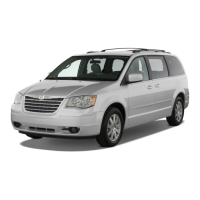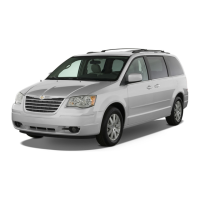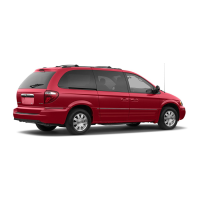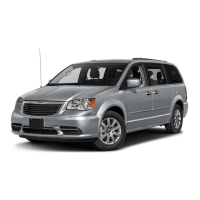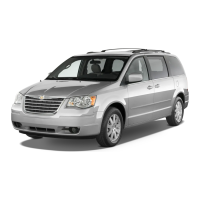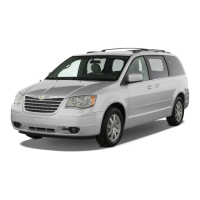
Do you have a question about the Chrysler 2008 Town & Country and is the answer not in the manual?
| Brand | Chrysler |
|---|---|
| Model | 2008 Town & Country |
| Category | Automobile |
| Language | English |
Important safety warnings and cautions to ensure safe operation and prevent vehicle damage.
Explanation of the keyless ignition system, including FOB and Wireless Ignition Node (WIN) operation.
Description of the Sentry Key Immobilizer System which prevents unauthorized vehicle operation by disabling the engine.
System that monitors doors and ignition for unauthorized operation, providing audible and visual signals.
System allowing remote locking/unlocking, panic alarm, and operation of power liftgate/sliding doors.
System to prevent children from opening sliding doors from inside.
Overview of vehicle restraint systems, including seat belts and airbags.
Operating instructions for lap/shoulder belts, including how the retractor locks.
Information about airbags as a supplement to seat belt restraint systems.
Details on dual-stage driver and front passenger airbags and their deployment.
Explanation of side airbags for enhanced protection during side impacts.
Description of SABIC airbags for side-impact protection.
Simple steps to minimize the risk of harm from a deploying airbag.
Information on the Occupant Restraint Controller (ORC) and its role in airbag deployment.
General information and legal requirements for child restraints in vehicles.
Information on different sizes and types of child restraints and proper usage.
Guidelines for using child restraints for older children and convertible seats.
Information about the LATCH child restraint anchorage system.
Guidance on carefully following manufacturer directions for installing child restraints.
Warnings and precautions regarding exhaust gases and carbon monoxide.
What the airbag warning light indicates and when to seek service.
Examination of tires for tread wear, damage, and proper inflation.
Introduction to the voice-activated, hands-free communication system.
Steps to pair a compatible Bluetooth-enabled cellular phone with the UConnect system.
How to contact emergency services using the UConnect system.
How to request towing assistance through the UConnect system.
Information on Sirius Satellite Radio service, its features, and activation.
Instructions for operating the Video Entertainment System.
How cellular phone operation can affect radio performance.
How the ATC system automatically maintains interior comfort levels.
Steps to take before starting the vehicle, including seat adjustment and seat belt fastening.
Troubleshooting steps if the engine does not start after following the normal procedure.
Precautions to prevent transmission damage when shifting gears.
How the parking brake operates and when the brake light illuminates.
Information on the dual hydraulic brake systems and how failures are indicated.
How the ABS system provides stability and performance by preventing wheel lock-up.
How the TCS system monitors wheel spin and reduces engine power for stability.
How rapid acceleration on slippery surfaces can cause pulling and loss of control.
Warnings and precautions for driving through water.
Information regarding tire markings, including size designation and load index.
Where to find tire and loading information and the importance of proper inflation.
General information about tires and the importance of proper inflation.
How improper tire pressure affects safety, economy, and ride comfort.
Warnings and precautions regarding spinning tires in stuck situations.
Recommendations for using equivalent replacement tires for safety and performance.
How the TPMS warns the driver of low tire pressure and system faults.
Fuel requirements for 3.3L & 3.8L gasoline engines.
Fuel requirements for 4.0L gasoline engines.
Information and precautions related to adding fuel to the vehicle.
Information specific to Flexible Fuel Vehicles with 3.3L engines.
General information about E-85 fuel and identifying compatible vehicles.
Regulations and guidelines for vehicle loading and weight limits.
How to determine maximum loading conditions for the vehicle and tires.
Safety tips and limits for towing a trailer with the vehicle.
Definition and importance of GVWR.
Definition of GTW and how to measure it.
Definition of GCWR and its components.
Definition and importance of GAWR.
Guidelines for loading trailers and calculating weight distribution.
Actions to take to reduce the potential for engine overheating.
Warnings and precautions related to using the jack and changing tires.
Steps for loosening lug nuts and removing the spare tire assembly.
Caution against jacking the vehicle on incorrect locations.
Warning about the instability of raising the vehicle higher than necessary.
Instructions for stowing the compact spare tire and cover assembly.
Step-by-step procedure for jump-starting a vehicle with a discharged battery.
How to move the vehicle when stuck in mud, sand, or snow using a rocking motion.
Caution against spinning wheels too fast to avoid transmission damage.
Conditions and limitations for towing a disabled vehicle.
Permitted limitations for flat towing vehicles with automatic transmissions.
Explanation of the OBD II system and its role in monitoring vehicle performance.
Information about qualified service personnel and tools available at the dealership.
Introduction to required maintenance services determined by engineers.
How to check the engine oil level and the recommended procedure.
Information on the oil change indicator system and recommended intervals.
Recommendations for checking and servicing the air conditioner at the start of warm seasons.
Warnings and procedures related to the radiator cooling fan and hot coolant.
Checking engine coolant protection, appearance, and recovery bottle tubing.
Periodic inspection of all brake system components for performance assurance.
How to check and maintain the brake fluid level in the master cylinder.
Checking fluid level in the automatic transaxle and its importance for longevity.
Location and types of fuses within the Totally Integrated Power Module (TIPM).
Table listing fuel, engine oil, and cooling system capacities in U.S. and Metric units.
Component-wise list of recommended fluids, lubricants, and genuine parts.
Importance of scheduled maintenance for the emission control system.
How the oil change indicator system works and when service is required.
Table detailing maintenance items, intervals in miles, kilometers, and months.
Table outlining maintenance tasks and their recommended intervals.
Tips for preparing for and obtaining service for the vehicle.
Information on contacting the manufacturer's customer center for assistance.
How to report safety defects to NHTSA and the manufacturer.
Description of tire grading categories established by the National Highway Traffic Safety Administration.
